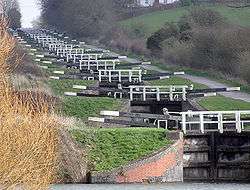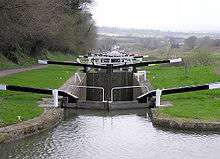Caen Hill Locks



Caen Hill Locks (pronounced "Cane"[1]) are a flight of locks on the Kennet and Avon Canal, between Rowde and Devizes in Wiltshire, England.
The 29 locks have a rise of 237 feet in 2 miles (72 m in 3.2 km) or a 1 in 44 gradient. The locks come in three groups. The lower seven locks, Foxhangers Wharf Lock to Foxhangers Bridge Lock, are spread over ¾ of a mile (1.2 km). The next sixteen locks form a steep flight in a straight line up the hillside and are designated as a scheduled monument.[2] Because of the steepness of the terrain, the pounds between these locks are very short. As a result, 15 locks have unusually large sideways-extended pounds, to store the water needed to operate them. A final six locks take the canal into Devizes.[3]
This flight of locks was engineer John Rennie's solution to climbing the very steep hill, and was the last part of the 87-mile route of the canal to be completed. Whilst the locks were under construction a tramroad provided a link between the canal at Foxhangers to Devizes, the remains of which can be seen in the towpath arches in the road bridges over the canal.[4] A brickyard was dug to the south of the workings to manufacture the bricks for the lock chambers and this remained in commercial use until the middle of the 20th century.
Because a large volume of water is needed for the locks to operate, a back pump was installed at Foxhangers in 1996 capable of returning 7 million gallons of water per day to the top of the flight, which is equivalent to one lockful every eleven minutes.[5]
In the early 19th century, 1829–43, the flight was lit by gas lights.[6]
The locks take 5–6 hours to traverse in a boat and lock 41 is the narrowest on the canal.[7]
After the coming of the railways, the canal fell into disuse and was closed. The last cargo through the flight was a consignment of grain conveyed from Avonmouth to Newbury in October 1948.[8] From the 1960s there was a major clearing and rebuilding operation, culminating in a visit by Queen Elizabeth II in 1990 to open the new locks officially, although the flight had been navigable for a number of years before then.
In 2010 British Waterways planned to install sixteen new locks gates in twelve weeks as part of its winter maintenance programme, in an attempt to reduce the amount of water lost.[9] The exceptionally cold weather delayed work, and when the section was re-opened at Easter 2010 only twelve pairs of gates had been dealt with.[10] The wood from the old gates was donated to Glastonbury Festival and used to build a new bridge which was named in honour of Arabella Churchill, one of the festival's founders.[11]
Locks
A number of the locks in the flight are named. These include Lock 42 (Monument Lock), Lock 43 (Queen Elizabeth Lock), Lock 44 (Sir Hugh Stockwell Lock), Lock 45 (Cave Lock), Lock 46 (A. P. Herbert Lock), Lock 47 (Manifold Lock), Lock 48 (Trust Lock), Lock 49 (Maton Lock) and Lock 50 (Kennet Lock).[12]
Restoration
 Plan from 1949, when still completely watered (Grid lines at 1000 metres)
Plan from 1949, when still completely watered (Grid lines at 1000 metres) Prior to restoration, early 1970s
Prior to restoration, early 1970s 1977, looking west
1977, looking west
 1977, looking uphill
1977, looking uphill 1977, from the bottom
1977, from the bottom 1985 — rewatered
1985 — rewatered
See also
- Locks on the Kennet and Avon Canal
- Bingley Five Rise Locks in West Yorkshire
- Bingley Three Rise Locks in West Yorkshire
- Foxton Locks near Market Harborough, Leicestershire
- Watford Locks in Northamptonshire
- Fourteen Locks near Newport, South Wales
- Tardebigge Locks near Bromsgrove, Worcestershire
References
- ↑ "Country Life magazine, vol 180". Google Books search result. 1986. p. 8. Retrieved 6 November 2015.
- ↑ Historic England. "Caen Hill locks (1004694)". National Heritage List for England. Retrieved 6 November 2015.
- ↑ "Devizes Branch - Locks". The Kennet and Avon Canal Trust website. Retrieved 2007-10-02.
- ↑ "Devizes Branch - Local History". The Kennet and Avon Canal Trust website. Archived from the original on 2007-09-07. Retrieved 2007-10-02.
- ↑ Pearson, Michael (2003). Kennet & Avon Middle Thames:Pearson's Canal Companion. Rugby: Central Waterways Supplies. ISBN 0-907864-97-X.
- ↑ "Caen Hill Locks". Kennet and Avon Scrapbook. Retrieved 2006-09-18.
- ↑ Allsop, Niall (1987). The Kennet & Avon Canal. Bath: Millstream Book. ISBN 0-948975-15-6.
- ↑ Clew, Kenneth (1968). The Kennet and Avon Canal (2 ed.). Newton Abbot, England: David and Charles. pp. 145–147. ISBN 0-7153-5939-8.
- ↑ "New locks for the Kennet & Avon Canal in Wiltshire". BBC. 2010-01-22. Retrieved 22 January 2010.
- ↑ Owen, Gill (22 March 2010). "Caen Hill open for Easter". Paddington, England: British Waterways. Retrieved 17 June 2010.
- ↑ Owen, Julian (2010-06-18). "Heart of Glasto". Venue. 924: 14–15.
- ↑ "Dec 2008 Assets". British Waterways. Retrieved 18 August 2015.
External links
 Media related to Caen Hill Locks at Wikimedia Commons
Media related to Caen Hill Locks at Wikimedia Commons
| Next lock upstream | Kennet and Avon Canal | Next lock downstream |
| Wootton Rivers Bottom Lock | Caen Hill Locks Grid reference: ST978614 |
Seend Locks |
Coordinates: 51°21′09″N 2°01′32″W / 51.35253°N 2.02559°W